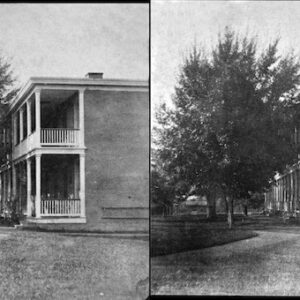Tag: Carlisle Barracks Officers’ quarters (Carlisle PA)
 Wikipedia says: Carlisle Barracks is a United States Army facility located in Carlisle, Pennsylvania. The site of the U.S. Army War College, it is the nation’s second-oldest active military base. The first structures were built in 1757, during the French and Indian War between Great Britain and France in the colonies.
Wikipedia says: Carlisle Barracks is a United States Army facility located in Carlisle, Pennsylvania. The site of the U.S. Army War College, it is the nation’s second-oldest active military base. The first structures were built in 1757, during the French and Indian War between Great Britain and France in the colonies.
Developed at the intersection of Indian trails along Letort Creek, in the eighteenth century the town of Carlisle became the jumping-off point for traders and settlers heading over the Alleghenies on their way west. A brief 1756 encampment at Carlisle preceded the more permanent settlement that started in May 1757, during the French and Indian War on the North American front between the colonies of Britain and France. Colonel John Stanwix marched upstream with British regulars and provincials against the backdrop of the international Seven Years’ War. After the American Revolutionary War, from 1783 to 1837, the town of Carlisle was significant as the frontier gateway, as a greatly increased wave of land-hungry migrants moved west.
During the Revolutionary War, numerous substantial brick buildings were erected at Carlisle Barracks for military stores and to accommodate workmen of the revolutionary government’s dedicated managing body for the Army, the Ordnance Department. While the facility might have been used to store ammunition and explosives, its lack of access to water transportation made it impractical because of the difficulty of overland travel at the time. The Hessian Powder Magazine, now Hessian Guardhouse Museum, was built in 1777.
In 1794, Carlisle Barracks became the center of intense federal military activity with the outbreak of the Whiskey Rebellion in the Pennsylvania backcountry. President George Washington journeyed to the barracks to review the troops—perhaps as many as 10,000 men. The crisis was posed by farmers in southwestern Pennsylvania, who refused to pay a tax on the commercial whiskey they distilled from their corn crops. They had found the alcohol more easily transported east over the Alleghenies and more profitable to sell than was corn as grain.
President Washington recommended the barracks as the site for a Federal military academy. But the state of New York won this prize, and West Point was developed on the west side of the Hudson River. The government decided to clear up ownership of the post; in 1801, the government paid $664.20 for the 27 acres (110,000 m2) which it had been renting from William Penn’s heirs.
In 1838 the US School of Cavalry Practice was established at Carlisle Barracks. It was the army’s small but elite mounted force, the forerunner of the Armor School now at Fort Benning, Georgia. Captain E. V. Sumner found most of the barracks buildings in disrepair, the maneuver area less than adequate, and horses in short supply. Overcoming these problems included drilling his recruits at the double time on foot to simulate the trotting of the missing horses. Another mounted organization, horse-drawn light artillery, also established its school at Carlisle Barracks. In 1839, Captain Samuel Ringgold arrived to begin training recruits and testing equipment for the “flying artillery,” as it was sometimes called.
Civil War
From the early Civil War days, south-central Pennsylvania was rife with rumors of a Confederate invasion up the Shenandoah-Cumberland Valley from Virginia to Pennsylvania. Although many miles from the combat front, the garrison at Carlisle became a central supply center for ordnance stores, horses, and quartermaster supplies under Captain David H. Hastings. Recruits once destined for Indian-fighting units on the western frontier were prepared to replace casualties in Regular Army units. Entire units were sent to the barracks to refit before specific deployment.
In June 1863, “the Rebels are coming!” was a cry with substance. In spite of a small defensive Pennsylvania militia and home guard force, Brigadier General Albert G. Jenkins’ Confederate cavalry entered Carlisle on 27 June. Jenkins led his mounted brigade east along the Trindle Road, where they bivouacked while they took rations by wagon from the town. He had levied a demand for food for his 1,500 men and forage for their horses. Three North Carolina brigades occupied Carlisle Barracks; the troops camped on the parade grounds.
Major General J.E.B. Stuart’s cavalry division approached Carlisle from the east on the afternoon of Wednesday, 1 July. Depleted by a sweeping march around the Union Army, Stuart hoped to find needed provisions; he did not know that other Confederate units had already sought the same Carlisle provisions. Stuart sent a demand for surrender of the Federal forces under the command of Brigadier General William Farrar Smith. When his demand was refused, Stuart initiated a short bombardment. When a second demand was refused, Stuart ordered his troops to shell the town and, later, to torch the barracks. See Battle of Carlisle.
After the Civil War ended, the barracks returned to its pre-war mission of receiving, training and forwarding cavalry recruits destined for the Indian wars on the western frontier. But, as army operations moved west, the War Department moved this function to the St. Louis Arsenal in Missouri. There it had access to transportation on the Mississippi and Missouri rivers. On 20 April 1871, Carlisle Barracks was officially “discontinued as a sub-Depot for the Mounted Recruit Service.” The installation was available for new uses.
Showing the single result
